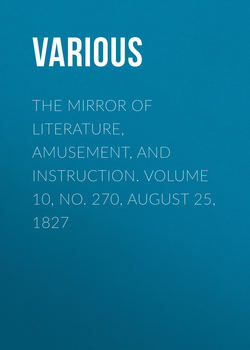Читать книгу The Mirror of Literature, Amusement, and Instruction. Volume 10, No. 270, August 25, 1827 - Various - Страница 1
TOWN-HALL, LIVERPOOL
ОглавлениеFrom a small inconsiderable hamlet, Liverpool, within a century and a half, has been singularly advanced in national importance. In Leland's time it had only a chapel, its parish church being at Walton, a distance of four miles from the town.
In the year 1571 the inhabitants of Liverpool sent a memorial to Queen Elizabeth, praying relief from a subsidy which they thought themselves unable to bear, wherein they styled themselves "her majesty's poor decayed town of Liverpool." Some time towards the close of this reign, Henry, Earl of Derby, in his way to the Isle of Man, staid at his house at Liverpool called the Tower; at which the corporation erected a handsome hall or seat for him in the church, where he honoured them several times with his presence.
Liverpool, from this time till the end of the next century, made but a slow progress either in the extent of its trade or in the number of its inhabitants; nor is there any remarkable occurrence recorded of it, except the siege of it by Prince Rupert, in the civil wars in 1644; some traces of which were discovered, when the foundation of the Liverpool Infirmary was sunk, particularly the marks of the trenches thrown up by the prince, and some cartouches, &c. left behind by the besiegers.
About the year 1698 an act of parliament was obtained, empowering the inhabitants to build a new church. From that time may be traced the rapid progress of population and commerce, until Liverpool has now become second only to the metropolis of Great Britain.
In 1760 the inhabitants of Liverpool were computed at 25,787; in 1811, at 94,376; and in 1821, at 118,972!
Far as the eye can trace the prospect round
The splendid tracts of opulence are found;
Yet scarce a hundred annual rounds have run.
Since first the fabric of this power begun;
His noble stream, inglorious, Mersey roll'd,
Nor felt his waves by lab'ring art controll'd:
Along his side a few small cots were spread,
His finny brood their humble tenants fed;
At op'ning dawn with fraudful nets supply'd
The padding skiff would brave his specious tide,
Ply round the shores, nor tempt the dangerous main,
But seek ere night the friendly port again.
The public buildings in Liverpool are not numerous, but they are worthy of attention. The Town-Hall, which is the subject of our present embellishment, is in a striking style of architecture. The first stone of this structure was laid in 1749, and the hall was opened in 1754. It is an elegant stone building, having two fronts; one towards Castle-street, the other towards the area formed by the New Exchange Buildings. Each front consists of an elegant range of Corinthian columns, supporting a pediment, and are themselves supported by a rustic base. Between the capitals are heads, and emblems of commerce in basso-relievo; and on the pediment of the grand front is a noble piece of sculpture representing Commerce committing her treasures to the race of Neptune. The ground floor of this building was originally intended as an Exchange for the accommodation of the merchants, with insurance offices adjoining; but was never used for that purpose, the merchants prefering to meet in the open street opposite the building. Since its erection a considerable addition was made to it on the north side, and some progress towards extending and improving the rooms and offices within the building, when the fire in 1795 destroyed the whole of the interior. After this destructive accident the corporation determined to rebuild the interior upon a new and extended plan, and to appropriate the whole of the building to the purposes of judicial and other offices for the police of the town, a mansion for the mayor, a suit of public assembly rooms, and for offices for the general corporation business. All the offices, rooms, and passages, on the basement and ground stories, are now arched with brick, as a security against any future fire.
The Exchange Buildings form three sides of a quadrangle, 194 feet by 180 in the clear space, with arcades or piazzas in front, and the whole is in a style of architecture corresponding with the north front of the Town-Hall and Old Exchange, which forms the fourth side of the square at the head of Castle-street. The east side of these buildings on the ground floor, contains a coffee-room, 94 feet by 52, with appropriate rooms and offices for the keeper, &c.; on the second story over the coffee-room, is a room for the under-writers, upon the principle of Lloyd's in London, 72 feet by 36: a second room, 69 feet by 29, with several other rooms attached to them. The north and west sides of these buildings are brokers' and merchants' offices, and counting houses. In the centre of the area is erected an elegant group of statues in commemoration of the heroic and immortal Nelson.
